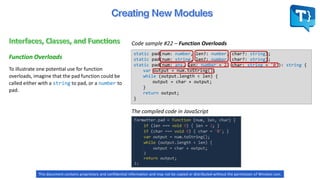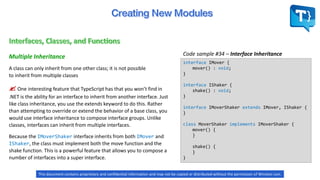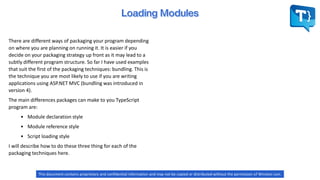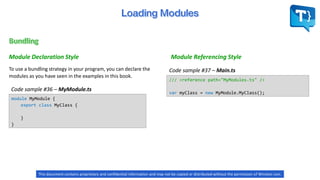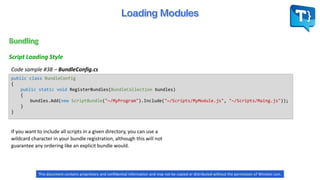Introduction to TypeScript by Winston Levi
- 1. Introduction to TypeScript by Winston Levi This document contains proprietary and confidential information and may not be copied or distributed without the permission of Winston Levi. [email protected]
- 2. This document contains proprietary and confidential information and may not be copied or distributed without the permission of Winston Levi.
- 3. This document contains proprietary and confidential information and may not be copied or distributed without the permission of Winston Levi.
- 4. TypeScript is converted into JavaScript at compile time. JavaScript is an implementation of the ECMAScript standard. There are three versions of ECMAScript that you will come across when dealing with TypeScript. It is the version supported in most browsers. When TypeScript compiles into JavaScript, it uses the ECMAScript 3 standards by default. The following browsers support all the important features of ECMAScript 5 : • Internet Explorer 9 and above. • Firefox 4 and above. • Opera 12 and above. • Safari 5.1 and above. • Chrome 7 and above. Older versions of these browsers have only partial support for this standard. This document contains proprietary and confidential information and may not be copied or distributed without the permission of Winston Levi.
- 5. ECMAScript 6 - Commonly referred to as "ES6", also known as ECMAScript Harmony. New to this Version: • Modules and classes part of the JavaScript language. TypeScript gives you immediate access to these new features, in practically all browsers. For browser's compatibility to the ECMAScript 6 follow this link: https://kangax.github.io/compat-table/es6/ This document contains proprietary and confidential information and may not be copied or distributed without the permission of Winston Levi.
- 6. Keep in mind to check checkbox indicating 'Compile on save' which compiles your TypeScript file into JavaScript file on each file save. Check checkbox indicating 'Allow implicit "any" types' to allow you to have undeclared variables in your code. Uncheck checkbox indicating 'Allow implicit "any" types' so that compiler will catch any instance where you did not declare the variable type in your TypeScript code. This document contains proprietary and confidential information and may not be copied or distributed without the permission of Winston Levi.
- 7. Figure #1 TypeScript Life Cycle This document contains proprietary and confidential information and may not be copied or distributed without the permission of Winston Levi.
- 8. TypeScript is referred as optionally statically typed, which means you can ask the compiler to ignore the type of a variable if you want to take advantage of dynamic typing in a particular circumstance. This mix of static and dynamic typing is already present in .NET; for example, C# is statically typed but allows dynamic types to be declared with the dynamic keyword. As well as compile-type checking, the language constructs allow static analysis that makes it possible for development tools to highlight errors in your code at design time without the need for compilation. This document contains proprietary and confidential information and may not be copied or distributed without the permission of Winston Levi.
- 9. Code sample #1 - Logging Function function log(message) { if (typeof window.console !== 'undefined') { window.console.log(message); } } var testLog = 'Hello world'; log(testLog); Which compiles to the following JavaScript code Table 1: Types in Code sample #1 Name Tooltip log (message: any) => void message any window.console Console testLog string There are several benefits to this type knowledge when it comes to writing your code. Firstly, if you try to assign a value to testLog that isn’t a string type, you will get a design-time warning and a compilation error. Figure #2 Precise autocompletion This document contains proprietary and confidential information and may not be copied or distributed without the permission of Winston Levi.
- 10. Code sample #2 - Logging Function function log(message: string) { if (typeof window.console !== 'undefined') { window.console.log(message); } } var testLog = 'Hello world'; log(testLog); Which compiles to the same JavaScript code as previous example Table 2: Types in Code sample #2 Name Tooltip log (message: sting) => void message sting window.console Console testLog string Code sample #3 - Function Call Type Checking // allowed log('Hello world'); // not allowed log(1); log(true); log({'key': 'value'}); This document contains proprietary and confidential information and may not be copied or distributed without the permission of Winston Levi.
- 11. Code sample #4 - Entirely Explicit Types function log(message: string): void { if (typeof window.console !== 'undefined') { window.console.log(message); } } var testLog: string = 'Hello world'; log(testLog); For both examples - the produced JavaScript code remains the same as been shown before. Code sample #5 - Pragmatic Explicit Types function log(message: string): void { if (typeof window.console !== 'undefined') { window.console.log(message); } } var testLog = 'Hello world'; log(testLog); This document contains proprietary and confidential information and may not be copied or distributed without the permission of Winston Levi.
- 12. TypeScript has five built-in primitive types as well as the dynamic any type, and the void return type. TypeScript Primitive Types: • number • boolean • string • null • undefined • enum This document contains proprietary and confidential information and may not be copied or distributed without the permission of Winston Levi.
- 13. Code sample #6 - Use of Null and Undefined The allowed declarations compiles into following JavaScript code, the not allowed part does not compiles:// allowed var a: string = null; var b: number = undefined; // not allowed var c: null; var d: undefined; // has a value of undefined var e: string; In fact, as long as the wrong code exists in TypeScript file, it will not compile into JS file. This document contains proprietary and confidential information and may not be copied or distributed without the permission of Winston Levi.
- 14. interface ILogger { } class Logger { } var loggerA: ILogger; var loggerB: Logger; // has a value of undefined var e: string; module MyModule { } var example: MyModule = MyModule; Code sample #7 – Custom Types Using Interfaces and Classes Code sample #8 – Using a Module as a Type This declarative code does not compiles into JS code. It is more for your own feature code and variable consistency, prevention of wrong type value assignment and variable tooltip. This document contains proprietary and confidential information and may not be copied or distributed without the permission of Winston Levi.
- 15. Another advanced type declaration allows you to specify that the type is a function. You do this by surrounding the definition in curly braces; for example, a function accepting a string parameter and not returning any value would have the following type declaration: var exampleA: string[] = []; Unlike other languages you may be using, the variable is initialized using either the array literal of empty square brackets [] or the new Array(10) constructor if you wish to specify the array length. The type is not used on the right-hand side of the statement. var exampleA: { (name: string): void; } = function (name: string) { }; This document contains proprietary and confidential information and may not be copied or distributed without the permission of Winston Levi.
- 16. Here are some examples of advanced type declarations in action: class Logger { } // exampleA's type is an array of Logger object. var exampleA: Logger[] = []; exampleA.push(new Logger()); exampleA.push(new Logger()); // exampleB's type is a function. It accepts an argument of type string and returns a number. var exampleB: { (input: string): number; }; exampleB = function (input: string) { return 1; }; // exampleC's type is an array of functions. Each function accepts a string and returns a number. var exampleC: { (input: string): number; } [] = []; var exampleCFunction(input: string): number; { return 10; } exampleC[0] = exampleCFunction; exampleC[1] = exampleCFunction; This document contains proprietary and confidential information and may not be copied or distributed without the permission of Winston Levi.
- 17. A helpful addition to the standard set of datatypes from JavaScript is the 'enum'. Like languages like C#, an enum is a way of giving more friendly names to sets of numeric values. enum Color {Red, Green, Blue}; var c: Color = Color.Green; Changing the memmbers numbering order enum Color {Red = 1, Green, Blue}; var c: Color = Color.Green; Or, even manually set all the values in the enum: enum Color {Red = 1, Green = 2, Blue = 4}; var c: Color = Color.Green; A handy feature of enums is that you can also go from a numeric value to the name of that value in the enum. enum Color {Red = 1, Green, Blue}; var colorName: string = Color[2]; alert(colorName); This document contains proprietary and confidential information and may not be copied or distributed without the permission of Winston Levi.
- 18. Hello World of Generics function identity(arg: number): number { return arg; } function identity(arg: any): any { return arg; } function identity<T>(arg: T): T { return arg; } Once we've written the generic identity function, we can call it in one of two ways. The first way is to pass all of the arguments, including the type argument, to the function: var output = identity<string>("myString"); // type of output will be 'string' The second way is also perhaps the most common. Here we use 'type argument inference', that is, we want the compiler to set the value of T for us automatically based on the type of the argument we pass in: var output = identity("myString"); // type of output will be 'string' This document contains proprietary and confidential information and may not be copied or distributed without the permission of Winston Levi.
- 19. What if we also want to log the length of the argument 'arg' to the console with each call. We might be tempted to write this:When you begin to use generics, you'll notice that when you create generic functions like 'identity', the compiler will enforce that you use any generically typed parameters in the body of the function correctly. That is, that you actually treat these parameters as if they could be any and all types. Let's take our 'identity' function from earlier: Working with Generic Type Variables function identity<T>(arg: T): T { return arg; } function loggingIdentity<T>(arg: T): T { console.log(arg.length); // Error: T doesn't have .length return arg; } This document contains proprietary and confidential information and may not be copied or distributed without the permission of Winston Levi.
- 20. We can alternatively write the sample example this way:Let's say that we've actually intended this function to work on arrays of T rather that T directly. Since we're working with arrays, the .length member should be available. We can describe this just like we would create arrays of other types: function loggingIdentity<T>(arg: Array<T>): Array<T> { console.log(arg.length); // Array has a .length, so no more error return arg; }function loggingIdentity<T>(arg: T[]): T[] { console.log(arg.length); // Array has a .length, so no more error return arg; } This document contains proprietary and confidential information and may not be copied or distributed without the permission of Winston Levi.
- 21. We could also have used a different name for the generic type parameter in the type, so long as the number of type variables, and how the type variables are used line up. The type of generic functions is just like those of non-generic functions, with the type parameters listed first, similarly to function declarations: Generic Types function identity<T>(arg: T): T { return arg; } var myIdentity: <T>(arg: T)=>T = identity; function identity<T>(arg: T): T { return arg; } var myIdentity: <U>(arg: U)=>U = identity; We can also write the generic type as a call signature of an object literal type: function identity<T>(arg: T): T { return arg; } var myIdentity: {<T>(arg: T): T} = identity; This document contains proprietary and confidential information and may not be copied or distributed without the permission of Winston Levi.
- 22. Which leads us to writing our first generic interface. Let's take the object literal from the previous example and move it to an interface: Generic Types interface GenericIdentityFn { <T>(arg: T): T; } function identity<T>(arg: T): T { return arg; } var myIdentity: GenericIdentityFn = identity; This document contains proprietary and confidential information and may not be copied or distributed without the permission of Winston Levi.
- 23. In a similar example, we may want to move the generic parameter to be a parameter of the whole interface. This lets us see what type(s) were generic over (e.g. Dictionary<string> rather than just Dictionary). This makes the type parameter visible to all the other members of the interface. Generic Types interface GenericIdentityFn<T> { (arg: T): T; } function identity<T>(arg: T): T { return arg; } var myIdentity: GenericIdentityFn<number> = identity; In addition to generic interfaces, we can also create generic classes. Note that it is not possible to create generic enums and modules. This document contains proprietary and confidential information and may not be copied or distributed without the permission of Winston Levi.
- 24. A generic class has a similar shape to a generic interface. Generic classes have a generic type parameter list in angle brackets (<>) following the name of the class. Generic Classes This is a pretty literal use of the 'GenericNumber' class, but you may have noticed that nothing is restricting it, to only use the 'number' type. We could have instead used 'string' or even more complex objects. class GenericNumber<T> { zeroValue: T; add: (x: T, y: T) => T; } var myGenericNumber = new GenericNumber<number>(); myGenericNumber.zeroValue = 0; myGenericNumber.add = function(x, y) { return x + y; }; var stringNumeric = new GenericNumber<string>(); stringNumeric.zeroValue = ""; stringNumeric.add = function(x, y) { return x + y; }; alert(stringNumeric.add(stringNumeric.zeroValue, "test")); This document contains proprietary and confidential information and may not be copied or distributed without the permission of Winston Levi.
- 25. Generic Constraints Instead of working with any and all types, we'd like to constrain this function to work with any and all types that also have the '.length' property. As long as the type has this member, we'll allow it, but it's required to have at least this member. To do so, we must list our requirement as a constraint on what T can be. function loggingIdentity<T>(arg: T): T { console.log(arg.length); // Error: T doesn't have .length return arg; } To do so, we will create an interface that describes our constraint. Here, we will create an interface that has a single '.length' property and then we will use this interface, and the 'extends' keyword to denote our constraint: interface Lengthwise { length: number; } function loggingIdentity<T extends Lengthwise>(arg: T): T { console.log(arg.length); // Now we know it has a .length property, so no more error return arg; } This document contains proprietary and confidential information and may not be copied or distributed without the permission of Winston Levi.
- 26. Generic Constraints Because the generic function is now constrained, it will no longer work over any and all types: loggingIdentity(3); // Error, number doesn't have a .length property Instead, we need to pass in values whose type has all the required properties: loggingIdentity({length: 10: value: 3}); This document contains proprietary and confidential information and may not be copied or distributed without the permission of Winston Levi.
- 27. Using Type Parameters in Generic Constraints In some cases, it may be useful to declare a type parameter that is constrained by another type parameter. For example, function find<T, U extends Findable<T>>(n: T, s: U) { // errors because type parameter used in constraint // ... } find(giraffe, myAnimals); This code is not strictly identical, as the return type of the first function could have returned 'U', which the second function pattern does not provide a means to do. You can achieve the pattern above by replacing the type parameter with its constraint. Rewriting the example above, function find<T>(n: T, s: Findable<T>) { // ... } find(giraffe, myAnimals); This document contains proprietary and confidential information and may not be copied or distributed without the permission of Winston Levi.
- 28. When creating factories in TypeScript using generics, it is necessary to refer to class types by their constructor functions. For example, Using Class Types in Generics function create<T>(c: {new(): T; }): T { return new c(); } A more advanced example uses the prototype property to infer and constrain relationships between the constructor function and the instance side of class types. class BeeKeeper { hasMask: boolean; } class ZooKeeper { nametag: string; } class Animal { numLegs: number; } class Bee extends Animal { keeper: BeeKeeper; } class Lion extends Animal { keeper: ZooKeeper; } function findKeeper<A extends Animal, K> (a: {new(): A; prototype: {keeper: K}}): K { return a.prototype.keeper; } findKeeper(Lion).nametag; // typechecks! This document contains proprietary and confidential information and may not be copied or distributed without the permission of Winston Levi.
- 29. In the following code, find out how you can model mixins in TypeScript. After the code, we will break it down, to understand how it works. Mixin Sample Along with traditional OO hierarchies, another popular way of building up classes from reusable components is to build them by combining simpler partial classes. You may be familiar with the idea of mixins or traits for languages like Scala, and the pattern has reached some popularity in the JavaScript community. // Disposable Mixin class Disposable { isDisposed: boolean; dispose() { this.isDisposed = true; } } // Activatable Mixin class Activatable { isActive: boolean; activate() { this.isActive = true; } deactivate() { this.isActive = false; } } Sample Part #1 This document contains proprietary and confidential information and may not be copied or distributed without the permission of Winston Levi.
- 30. class SmartObject implements Disposable, Activatable { constructor() { setInterval(() => console.log(this.isActive + " :" + this.isDisposed), 500); } interact() { this.activate(); } // Disposable isDisposed: boolean = false; dispose: () => void; // Activatable isActive: boolean = false; activate: () => void; deactivate: () => void; } applyMixins(SmartObject, [Disposable, Activatable]) var smartObj = new SmartObject(); // implement activate method from Activatable class // using interact method setTimeout(() => smartObj.interact(), 1000); Sample Part #2 Sample Part #3 This document contains proprietary and confidential information and may not be copied or distributed without the permission of Winston Levi.
- 31. Sample Part #4 ///////////////////////////////////////////////////////// // Register this code somewhere in your runtime library ///////////////////////////////////////////////////////// function applyMixins(derivedCtor: any, baseCtors: any[]) { baseCtors.forEach(baseCtor => { Object.getOwnPropertyNames(baseCtor.prototype).forEach(name => { derivedCtor.prototype[name] = baseCtor.prototype[name]; }) }); } This document contains proprietary and confidential information and may not be copied or distributed without the permission of Winston Levi.
- 32. The code sample starts with the two classes that will act as our mixins. You can see that each one focuses on a particular activity or capability. We will later mix these together to form a new class from both capabilities. Understanding the Sample // Disposable Mixin class Disposable { isDisposed: boolean; dispose() { this.isDisposed = true; } } // Activatable Mixin class Activatable { isActive: boolean; activate() { this.isActive = true; } deactivate() { this.isActive = false; } } Sample Part #1 This document contains proprietary and confidential information and may not be copied or distributed without the permission of Winston Levi.
- 33. class SmartObject implements Disposable, Activatable { constructor() { setInterval(() => console.log(this.isActive + " :" + this.isDisposed), 500); } interact() { this.activate(); } // Disposable isDisposed: boolean = false; dispose: () => void; // Activatable isActive: boolean = false; activate: () => void; deactivate: () => void; } applyMixins(SmartObject, [Disposable, Activatable]) var smartObj = new SmartObject(); // implement activate method from Activatable class // using interact method setTimeout(() => smartObj.interact(), 1000); Sample Part #2 Sample Part #3 This document contains proprietary and confidential information and may not be copied or distributed without the permission of Winston Levi.
- 34. Sample Part #4 ///////////////////////////////////////////////////////// // Register this code somewhere in your runtime library ///////////////////////////////////////////////////////// function applyMixins(derivedCtor: any, baseCtors: any[]) { baseCtors.forEach(baseCtor => { Object.getOwnPropertyNames(baseCtor.prototype).forEach(name => { derivedCtor.prototype[name] = baseCtor.prototype[name]; }) }); } This document contains proprietary and confidential information and may not be copied or distributed without the permission of Winston Levi.
- 35. The code sample starts with the two classes that will act as our mixins. You can see that each one focuses on a particular activity or capability. We will later mix these together to form a new class from both capabilities. Understanding the Sample // Disposable Mixin class Disposable { isDisposed: boolean; dispose() { this.isDisposed = true; } } // Activatable Mixin class Activatable { isActive: boolean; activate() { this.isActive = true; } deactivate() { this.isActive = false; } } Sample Part #1 This document contains proprietary and confidential information and may not be copied or distributed without the permission of Winston Levi.
- 36. Next, we are creating the class that will handle the combination of the two mixins. Let's look at this in more detail to see how it does this: Understanding the Sample continued class SmartObject implements Disposable, Activatable { This document contains proprietary and confidential information and may not be copied or distributed without the permission of Winston Levi.
- 37. Understanding the Sample continued Finally, we mix our mixins into the class, creating the full implementation by calling to the following function. applyMixins(SmartObject, [Disposable, Activatable]) // Disposable isDisposed: boolean = false; dispose: () => void; // Activatable isActive: boolean = false; activate: () => void; deactivate: () => void; Properties and their types declaration for the members This document contains proprietary and confidential information and may not be copied or distributed without the permission of Winston Levi.
- 38. Understanding the Sample continued This function is needed somewhere in program from where it can be accessed by all the mixins – it has to be included only once. This function may be wrapped within a module or a class, if you want it. function applyMixins(derivedCtor: any, baseCtors: any[]) { baseCtors.forEach(baseCtor => { Object.getOwnPropertyNames(baseCtor.prototype).forEach(name => { derivedCtor.prototype[name] = baseCtor.prototype[name]; }) }); } The Important bits of this example are: • You use the implements keyword, not the extends keyword. • You need to have a matching signature to keep the compiler quiet (but it does not need real implementation – it will get that from the mixin). • You need to call applyMixins with the correct arguments. This document contains proprietary and confidential information and may not be copied or distributed without the permission of Winston Levi.
- 39. For variables and parameters that are initialized with a value, TypeScript will infer the type from the initial value. For example, TypeScript infers the correct types for all of the following examples by inspecting the initial value even if the initial value comes from another variable: Code sample #8 – Type Inference class ExampleClass { } function myFunction(parameter = 5) { // number } var myString = 'Hellow World'; // string var myBool = true; // boolean var myNumber = 1.23; // number var myExampleClass = new ExampleClass(); // ExampleClass var myStringArray = ['hello', 'world']; // string[] var anotherBool = myBool; // boolean The compiled code in JavaScript This document contains proprietary and confidential information and may not be copied or distributed without the permission of Winston Levi.
- 40. Code sample #9 – Inferred Any Type The compiled code in JavaScript var example; // any example = 'string'; // still any Code sample #10 – Inferred Any Type function example (myBool: boolean) { // any if (myBool) { return 'hello'; // string } return 1; // number } There will be no JavaScript code since there is a conflict with returned type. This document contains proprietary and confidential information and may not be copied or distributed without the permission of Winston Levi.
- 41. Code sample #11 – Contextual Typing Type inference uses a widened type when the initial value of a variable, parameter, or function return value is deemed to be null or undefined. In these cases, the dynamic any type is used. Code sample #12 – Widened Types var func: { (param: number): number; }; func = function (a) { // a is inferred to be number, // based on the type declaration // of the func variable. return a++; } var a = undefined; // any var b = null; // any var c = [null, null]; // any[] var d = { a: undefined; b: 1 }; // { a: any; b: number } This document contains proprietary and confidential information and may not be copied or distributed without the permission of Winston Levi.
- 42. If you are writing a large-scale application, you can nest your modules just like you nest namespaces in .Net. The aim should be to make the components of your program easy to discover using autocompletion. For a discussion on Modules I will name the program Succinctly and the first module Utilities. Code sample #13 – Utilities Module Declaring a Module module Sunccinctly { module Utilities { } } This document contains proprietary and confidential information and may not be copied or distributed without the permission of Winston Levi.
- 43. To add a class to a module, you use the class keyword. You can then place variables and functions inside the class. Code sample #14 – Logger Class (Utilities.ts) Adding a Class to a Module module Utilities { export class Logger { log(message: string):void { if (typeof window.console !== 'undefined') { window.console.log(message); } } } } Code sample #15 – Calling the Logger ///<reference path="Utilities.ts" /> Window.onload = function () { var logger = new Utilities.Logger(); logger.log('Logger is loaded'); }; This gives you powerful code organization tools that closely match those available in .NET - you can imagine what the entire TypeScript program might look like: • Utilities.Logger • Utilities.Dates • Messaging.Ajax • Messaging.JsonConverter • Messagin.XmlConverter This document contains proprietary and confidential information and may not be copied or distributed without the permission of Winston Levi.
- 44. Private Functions Code sample #16 – Private Function module Utilities { export class Logger { log(message: string): void { if (typeof window.console !== 'undefined') { window.console.log(this.getTimeStamp() + '-' + message); } } private getTimeStamp(): string { var now = new Date(); return now.getHours() + ':' + now.getMinutes() + ':' + now.getSeconds() + ':' + now.getMilliseconds(); } } } Type safety, interfaces, and protection of private variables and functions only occurs at design time and compilation time in TypeScript. This document contains proprietary and confidential information and may not be copied or distributed without the permission of Winston Levi.
- 45. If you run the latest example, you will see that the message is now prefixed with a timestamp, but that the format isn’t quite right: 15:39:1:767 - Logger is loaded. When the hours, minutes, or seconds are less than two digits, or when the milliseconds are less than three digits, the value should be left- padded with zeros to preserve the time stamp format. Static Functions Code sample #17 – Static Function module Utilities { export class Logger { log(message: string): void { if (typeof window.console !== 'undefined') { window.console.log(this.getTimeStamp() + '-' + message); } } private getTimeStamp(): string { var now = new Date(); return Formatter.pad(now.getHours(), 2, '0') + ':' + Formatter.pad(now.getMinutes(), 2, '0') + ':' + Formatter.pad(now.getSeconds(), 2, '0') + ':' + Formatter.pad(now.getMilliseconds(), 3, '0'); } } class Formatter { static pad(num: number, len: number, char: string): string { var output = num.toString(); while (output.length < len) { output = char + output; } return output; } } } Currently available only in this module since export keyword is omitted This document contains proprietary and confidential information and may not be copied or distributed without the permission of Winston Levi.
- 46. Static Functions The compiled code in JavaScript In JavaScript Formatter is exposed for all, since in JavaScript there is no Type Safety This document contains proprietary and confidential information and may not be copied or distributed without the permission of Winston Levi.
- 47. // before return Formatter.pad(now.getHours(), 2, '0') + ':' + Formatter.pad(now.getMinutes(), 2, '0') + ':' + Formatter.pad(now.getSeconds(), 2, '0') + ':' + Formatter.pad(now.getMilliseconds(), 3, '0'); // after return Formatter.pad(now.getHours()) + ':' + Formatter.pad(now.getMinutes()) + ':' + Formatter.pad(now.getSeconds()) + ':' + Formatter.pad(now.getMilliseconds(), 3); Code sample #18 – Default Parameters Default Parameters Code sample #19 – Calling a function that has default parameters // before static pad(num: number; len: number, char: string) { // after static pad(num: number; len: number = 2, chart: string = '0') { This new declaration do not affect the compiled JavaScript code. It is useful for TypeScript code validation and tooltip. Using an equal sign after type declaration you assign default value This document contains proprietary and confidential information and may not be copied or distributed without the permission of Winston Levi.
- 48. Code sample #20 – Optional Parameters Optional Parameters static pad(num: number, len: number = 2, char?: string) { if (!char) { char = '0'; } } Here I check for presence of argument using If block, and set value if it wasn't passed (like default value) The compiled code in JavaScript This document contains proprietary and confidential information and may not be copied or distributed without the permission of Winston Levi.
- 49. Rest Parameters Code sample #21 – Rest Parameters function addManyNumbers(…numbers: number[]) { var sum = 0; for (var i = 0; i < numbers.length; i++) { sum += numbers[i]; } return sum; } var result = addManyNumbers(1,2,3,5,6,7,8,9); // 41 The compiled code in JavaScript Code sample #22 – Mixed Normal and Rest Parameters function addManyNumbers(name: string, …numbers: number[]) { This document contains proprietary and confidential information and may not be copied or distributed without the permission of Winston Levi.
- 50. Function Overloads To illustrate one potential use for function overloads, imagine that the pad function could be called either with a string to pad, or a number to pad. Code sample #22 – Function Overloads static pad(num: number, len?: number, char?: string); static pad(num: string, len?: number, char?: string); static pad(num: any, len: number = 2, char: string = '0'): string { var output = num.toString(); while (output.length < len) { output = char + output; } return output; } The compiled code in JavaScript This document contains proprietary and confidential information and may not be copied or distributed without the permission of Winston Levi.
- 51. Function Overloads Code sample #23 – Default Parameters // before static pad(num: number; len: number, char: string) { // after static pad(num: number; len: number = 2, chart: string = '0') { This document contains proprietary and confidential information and may not be copied or distributed without the permission of Winston Levi.
- 52. Function Overloads Code sample #24 – Alternative to Function Overloads The compiled code in JavaScript static padNumber(num: any, len?: number, char?: string): string { return padString(num.toString(), len, char); } static padString(input: string, len: number = 2, char: string = '0'): string { var output = input; while (output.length < len) { output = char + output; } return output; } This document contains proprietary and confidential information and may not be copied or distributed without the permission of Winston Levi.
- 53. Constructors Code sample #25 – Constructor export class Logger{ constructor (private formatter: Formatter) { } log(message: string): void { if (typeof window.console !== 'undefined') { window.console.log(this.getTimeStamp() + ' – ' + message); } } private getTimeStamp(): string { var now = new Date(); return this.formatter.pad(now.getHours()) + ':' + this.formatter.pad(now.getMinutes()) + ':' + this.formatter.pad(now.getSeconds()) + ':' + this.formatter.pad(now.getMilliseconds(), 3); } } This document contains proprietary and confidential information and may not be copied or distributed without the permission of Winston Levi.
- 54. Constructors The compiled code in JavaScript To create an instance of the Logger class, you are required to pass in a Formatter. The development tools and compiler will check that you do. Code sample #26 – Calling a Constructor var formatter = new Utilities.Formatter(); var logger = new Utilities.Logger(formatter); Remember, you will need to add the export keyword to the formatter. This document contains proprietary and confidential information and may not be copied or distributed without the permission of Winston Levi.
- 55. Interfaces Interfaces declared using the interface keyword and you can make an interface available outside of a module using the export keyword, just as you can with a class. Code sample #27 – Ilogger Interface export interface ILogger { log(message: string): void; } Code sample #28 – Implementing Ilogger Interface export class Logger implements ILogger { This document contains proprietary and confidential information and may not be copied or distributed without the permission of Winston Levi.
- 56. Interfaces Code sample #30 – New Logger Class implementing multiple interfaces Code sample #29 – New Logger Class export class AnnoyingLogger implements ILogger { log(message: string): void { alert(message); } } Multiple Interfaces In TypeScript a class can implement more than one interface. To do this, separate each interface with a comma: export class MyClass implements IFirstInterface, ISecondInterface { This document contains proprietary and confidential information and may not be copied or distributed without the permission of Winston Levi.
- 57. Duck Typing Code sample #31 – Duck Typing interface IPerson { firstName: string; lastName: string; } class Person implements IPerson { constructor(public firstName: string, public lastName: string) { } } var personA: IPerson = new Person('Jane', 'Smith'); // explicit var personB: IPerson = { firstName: 'Jo', lastName: 'Smith' }; // duck typing function printName(personObj: IPerson) { console.log(personObj.firstName); } It is worth pointing out that the type-checker doesn't require that these properties come in any sort of order, only that the properties the interface requires are present and have the required type. This document contains proprietary and confidential information and may not be copied or distributed without the permission of Winston Levi.
- 58. Inheritance and Polymorphism Code sample #32 – Inheritance and Polymorphism export class AnnoyingLogger extends Logger { log(message: string): void { alert(message); super.log(message); } } To inherit from a class, you use the extends keyword. The log function alerts the user before calling the base Logger class, which you can access with the super keyword. The result of this function is that an alert dialog will be displayed, and when it is closed, a message will be added to the console, if one is running. This document contains proprietary and confidential information and may not be copied or distributed without the permission of Winston Levi.
- 59. Inheritance and Polymorphism Code sample #33 – Calling the Logger ///<reference path='Utilities.ts'/> window.onload = function () { var logger: Utilities.ILoggeer = new Utilities.AnnoyingLogger(); Logger.log('Logger is loaded'); } This document contains proprietary and confidential information and may not be copied or distributed without the permission of Winston Levi.
- 60. Code sample #34 – Interface InheritanceMultiple Inheritance interface IMover { mover() : void; } interface IShaker { shake() : void; } interface IMoverShaker extends IMover, IShaker { } class MoverShaker implements IMoverShaker { mover() { } shake() { } } Because the IMoverShaker interface inherits from both IMover and IShaker, the class must implement both the move function and the shake function. This is a powerful feature that allows you to compose a number of interfaces into a super interface. A class can only inherit from one other class; it is not possible to inherit from multiple classes One interesting feature that TypeScript has that you won’t find in .NET is the ability for an interface to inherit from another interface. Just like class inheritance, you use the extends keyword to do this. Rather than attempting to override or extend the behavior of a base class, you would use interface inheritance to compose interface groups. Unlike classes, interfaces can inherit from multiple interfaces. This document contains proprietary and confidential information and may not be copied or distributed without the permission of Winston Levi.
- 61. Super Inheritance Figure #3 A Super Interface The super interface in this diagram is the IAmphibian interface. A class that implements this super interface can do everything shown on the right-hand side of the diagram. Without the super interface, it would be hard to express that a class needed both IBoat and ICar interfaces to be valid for a given operation. This document contains proprietary and confidential information and may not be copied or distributed without the permission of Winston Levi.
- 62. Code sample #35 – Instance Of Using instanceof The instanceof keyword can be used to compare an instance to a known type. It will return true if the instance is of the known type, or inherits from the known type. For example, the AnnoyingLogger class is an instance of AnnoyingLogger, and it is also an instance of Logger. var isLogger = logger instanceof Utilities.Logger; // true var isLogger = logger instanceof Utilities.AnnoyingLogger; // true var isLogger = logger instanceof Utilities.Formatter; // false This document contains proprietary and confidential information and may not be copied or distributed without the permission of Winston Levi.
- 63. There are different ways of packaging your program depending on where you are planning on running it. It is easier if you decide on your packaging strategy up front as it may lead to a subtly different program structure. So far I have used examples that suit the first of the packaging techniques: bundling. This is the technique you are most likely to use if you are writing applications using ASP.NET MVC (bundling was introduced in version 4). The main differences packages can make to you TypeScript program are: • Module declaration style • Module reference style • Script loading style I will describe how to do these three thing for each of the packaging techniques here. This document contains proprietary and confidential information and may not be copied or distributed without the permission of Winston Levi.
- 64. Module Declaration Style To use a bundling strategy in your program, you can declare the modules as you have seen in the examples in this book. Code sample #37 – Main.ts Code sample #36 – MyModule.ts Module Referencing Style module MyModule { export class MyClass { } } /// <reference path="MyModules.ts" /> var myClass = new MyModule.MyClass(); This document contains proprietary and confidential information and may not be copied or distributed without the permission of Winston Levi.
- 65. Script Loading Style Code sample #38 – BundleConfig.cs public class BundleConfig { public static void RegisterBundles(BundleCollection bundles) { bundles.Add(new ScriptBundle("~/MyProgram").Include("~/Scripts/MyModule.js", "~/Scripts/Maing.js")); } } If you want to include all scripts in a given directory, you can use a wildcard character in your bundle registration, although this will not guarantee any ordering like an explicit bundle would. This document contains proprietary and confidential information and may not be copied or distributed without the permission of Winston Levi.
- 66. Script Loading Style Code sample #39 – Bundle Using Wildcard Character public class BundleConfig { public static void RegisterBundles(BundleCollection bundles) { bundles.Add(new ScriptBundle("~/bundles/MyProgram").Include("~/Scripts/*")); } } Code sample #40 – Using the Bundle @Script.Render("~/bundles/MyProgram") This document contains proprietary and confidential information and may not be copied or distributed without the permission of Winston Levi.
- 67. CommonJS is intended to provide a common standard library for JavaScript that makes it easier to run as a server-side language, command-line tool, or desktop application. The most famous implementation of CommonJS is the highly scalable Node.js, which runs on Google’s V8 JavaScript engine. http://www.commonjs.org/ If you are targeting a platform such as Node.js, which implements a CommonJS runtime module loader, you can tell the TypeScript compiler to generate code that works out of the box with CommonJS. To do this, add a module switch to the TypeScript compiler command in your project file. <Exec Command=""$(PROGRAMFILES)Microsoft SDKsTypeScripttsc" -- module commonjs @(TypeScriptCompile ->'"%(fullpath)"', ' ')" /> This document contains proprietary and confidential information and may not be copied or distributed without the permission of Winston Levi.
- 68. Code sample #41 – MyModule.ts Module Declaration Style export class MyClass { } This document contains proprietary and confidential information and may not be copied or distributed without the permission of Winston Levi.
- 69. Code sample #42 – Main.ts Module Reference Style import myModule = module('MyModule'); // MyModule.ts var myClass = new myModule.MyClass(); Script Loading Style All of the scripts required by your Main.js file will be automatically loaded by the CommonJS library. Summary TypeScript’s CommonJS support is tailored for platforms such as Node.js, although there are many more implementations that you may not have heard of, such as Narwhal and CouchDB. This document contains proprietary and confidential information and may not be copied or distributed without the permission of Winston Levi.
- 70. AMD stands for Asynchronous Module Definition and is an API that allows your modules to be loaded asynchronously on an as needed basis. This is actually a pattern adapted from CommonJS intended to be used in web browsers. To use AMD, you will need to add a module-loader to your program, such as RequireJS. http://requirejs.org/ To get AMD output from the TypeScript compiler, set the module mode to “amd” in your project file. <Exec Command=""$(PROGRAMFILES)Microsoft SDKsTypeScripttsc" -- module amd @(TypeScriptCompile ->'"%(fullpath)"', ' ')" /> This document contains proprietary and confidential information and may not be copied or distributed without the permission of Winston Levi.
- 71. Code sample #43 – MyModule.ts Module Declaration Style export class MyClass { } Code sample #44 – Main.ts Module Reference Style import myModule = module('MyModule'); // MyModule.ts var myClass = new myModule.MyClass(); This document contains proprietary and confidential information and may not be copied or distributed without the permission of Winston Levi.
- 72. Script Loading Style <script src="Scripts/require.js" data-main="Scripts/Main"></script> Specify your main program file This document contains proprietary and confidential information and may not be copied or distributed without the permission of Winston Levi.
- 73. If you are designing a program that will run on the server, as well as in a browser, you can write your modules in the CommonJS style, and use the TypeScript compiler to give you the CommonJS and the AMD flavors of compiled JavaScript without having to change your code. While your TypeScript remains unchanged between the two platforms, the CommonJS output will use the built-in require function, while the AMD output will call RequireJS. This document contains proprietary and confidential information and may not be copied or distributed without the permission of Winston Levi.
- 74. This document contains proprietary and confidential information and may not be copied or distributed without the permission of Winston Levi.
- 75. Code sample #45 – Simple Ambient Declaration declare var externalLogger; externalLogger.anything(); Code sample #46 – Ambient Class Definition declare class ExternalLogger { log(message: string): void; } declare var externalLogger: ExternalLogger; externalLogger.anything(); This document contains proprietary and confidential information and may not be copied or distributed without the permission of Winston Levi.
- 76. Code sample #47 – Ambient Class Definition declare module ExternalUtilities { export class ExternalLogger { public totalLogs: number; log(message: string): void; } } var externalLogger = new ExternalUtilities.ExternalLogger(); externalLogger.log("Hello World"); var logCount = externalLogger.totalLogs; This document contains proprietary and confidential information and may not be copied or distributed without the permission of Winston Levi.
- 77. You can place your ambient declaration in a separate file. If you do so, you should use a .d.ts file extension, for example, ExternalLogger.d.ts. This file can then be referenced or imported just like any other TypeScript file. Code sample #48 – Referencing Ambient Declaration File /// <reference path="ExternalLogger.d.ts" /> var externalLogger = new ExternalUtilities.ExternalLogger(); externalLogger.log("Hello World"); externalLogger.anything(); This document contains proprietary and confidential information and may not be copied or distributed without the permission of Winston Levi.
- 78. Figure #3 A Super Interface This document contains proprietary and confidential information and may not be copied or distributed without the permission of Winston Levi.
- 79. Open Visual Studio 2013 Open Tools menu Extensions and Updates… sub menu and follow the steps described in following image You can also download this file directly from TypeScript Language website at http://www.typescriptlang.org/ This document contains proprietary and confidential information and may not be copied or distributed without the permission of Winston Levi.
- 80. Installing the extension adds TypeScript language support to the Visual Studio. Now there is a support for new Project Type and File Templates. This document contains proprietary and confidential information and may not be copied or distributed without the permission of Winston Levi.
- 81. Adding TypeScript File to the Solution. Right click on the Solution in Solution Explorer window, Select Add and from sub-menu select TypeScript File as seen in image. This document contains proprietary and confidential information and may not be copied or distributed without the permission of Winston Levi.






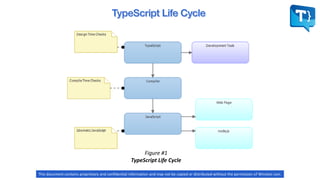







![Another advanced type declaration allows you to specify that
the type is a function. You do this by surrounding the definition
in curly braces; for example, a function accepting a string
parameter and not returning any value would have the following
type declaration:
var exampleA: string[] = [];
Unlike other languages you may be using, the variable is initialized
using either the array literal of empty square brackets [] or the new
Array(10) constructor if you wish to specify the array length. The
type is not used on the right-hand side of the statement.
var exampleA: { (name: string): void; } = function (name: string) { };
This document contains proprietary and confidential information and may not be copied or distributed without the permission of Winston Levi.](https://image.slidesharecdn.com/introductiontotypescriptbywinstonlevi-170216131827/85/Introduction-to-TypeScript-by-Winston-Levi-15-320.jpg)
![Here are some examples of
advanced type declarations in action:
class Logger { }
// exampleA's type is an array of Logger object.
var exampleA: Logger[] = [];
exampleA.push(new Logger());
exampleA.push(new Logger());
// exampleB's type is a function. It accepts an argument of type string and returns a
number.
var exampleB: { (input: string): number; };
exampleB = function (input: string) {
return 1;
};
// exampleC's type is an array of functions. Each function accepts a string and returns a
number.
var exampleC: { (input: string): number; } [] = [];
var exampleCFunction(input: string): number; {
return 10;
}
exampleC[0] = exampleCFunction;
exampleC[1] = exampleCFunction;
This document contains proprietary and confidential information and may not be copied or distributed without the permission of Winston Levi.](https://image.slidesharecdn.com/introductiontotypescriptbywinstonlevi-170216131827/85/Introduction-to-TypeScript-by-Winston-Levi-16-320.jpg)
![A helpful addition to the standard set of datatypes from
JavaScript is the 'enum'. Like languages like C#, an
enum is a way of giving more friendly names to sets of
numeric values.
enum Color {Red, Green, Blue};
var c: Color = Color.Green;
Changing the memmbers numbering order
enum Color {Red = 1, Green, Blue};
var c: Color = Color.Green;
Or, even manually set all the values in the enum:
enum Color {Red = 1, Green = 2, Blue = 4};
var c: Color = Color.Green;
A handy feature of enums is that you can also go from a
numeric value to the name of that value in the enum.
enum Color {Red = 1, Green, Blue};
var colorName: string = Color[2];
alert(colorName);
This document contains proprietary and confidential information and may not be copied or distributed without the permission of Winston Levi.](https://image.slidesharecdn.com/introductiontotypescriptbywinstonlevi-170216131827/85/Introduction-to-TypeScript-by-Winston-Levi-17-320.jpg)


![We can alternatively write the sample example this way:Let's say that we've actually intended this function to work on
arrays of T rather that T directly. Since we're working with arrays,
the .length member should be available. We can describe this just
like we would create arrays of other types:
function loggingIdentity<T>(arg: Array<T>): Array<T> {
console.log(arg.length);
// Array has a .length, so no more error
return arg;
}function loggingIdentity<T>(arg: T[]): T[] {
console.log(arg.length);
// Array has a .length, so no more error
return arg;
}
This document contains proprietary and confidential information and may not be copied or distributed without the permission of Winston Levi.](https://image.slidesharecdn.com/introductiontotypescriptbywinstonlevi-170216131827/85/Introduction-to-TypeScript-by-Winston-Levi-20-320.jpg)


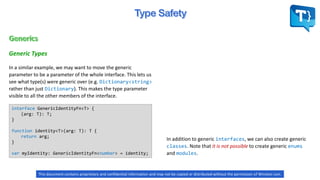





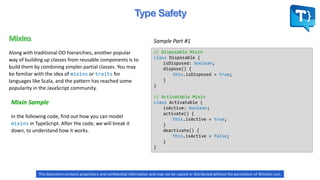
![class SmartObject implements Disposable, Activatable {
constructor() {
setInterval(() => console.log(this.isActive + " :" +
this.isDisposed), 500);
}
interact() {
this.activate();
}
// Disposable
isDisposed: boolean = false;
dispose: () => void;
// Activatable
isActive: boolean = false;
activate: () => void;
deactivate: () => void;
}
applyMixins(SmartObject, [Disposable, Activatable])
var smartObj = new SmartObject();
// implement activate method from Activatable class
// using interact method
setTimeout(() => smartObj.interact(), 1000);
Sample Part #2 Sample Part #3
This document contains proprietary and confidential information and may not be copied or distributed without the permission of Winston Levi.](https://image.slidesharecdn.com/introductiontotypescriptbywinstonlevi-170216131827/85/Introduction-to-TypeScript-by-Winston-Levi-30-320.jpg)
![Sample Part #4
/////////////////////////////////////////////////////////
// Register this code somewhere in your runtime library
/////////////////////////////////////////////////////////
function applyMixins(derivedCtor: any, baseCtors: any[]) {
baseCtors.forEach(baseCtor => {
Object.getOwnPropertyNames(baseCtor.prototype).forEach(name => {
derivedCtor.prototype[name] = baseCtor.prototype[name];
})
});
}
This document contains proprietary and confidential information and may not be copied or distributed without the permission of Winston Levi.](https://image.slidesharecdn.com/introductiontotypescriptbywinstonlevi-170216131827/85/Introduction-to-TypeScript-by-Winston-Levi-31-320.jpg)

![class SmartObject implements Disposable, Activatable {
constructor() {
setInterval(() => console.log(this.isActive + " :" +
this.isDisposed), 500);
}
interact() {
this.activate();
}
// Disposable
isDisposed: boolean = false;
dispose: () => void;
// Activatable
isActive: boolean = false;
activate: () => void;
deactivate: () => void;
}
applyMixins(SmartObject, [Disposable, Activatable])
var smartObj = new SmartObject();
// implement activate method from Activatable class
// using interact method
setTimeout(() => smartObj.interact(), 1000);
Sample Part #2 Sample Part #3
This document contains proprietary and confidential information and may not be copied or distributed without the permission of Winston Levi.](https://image.slidesharecdn.com/introductiontotypescriptbywinstonlevi-170216131827/85/Introduction-to-TypeScript-by-Winston-Levi-33-320.jpg)
![Sample Part #4
/////////////////////////////////////////////////////////
// Register this code somewhere in your runtime library
/////////////////////////////////////////////////////////
function applyMixins(derivedCtor: any, baseCtors: any[]) {
baseCtors.forEach(baseCtor => {
Object.getOwnPropertyNames(baseCtor.prototype).forEach(name => {
derivedCtor.prototype[name] = baseCtor.prototype[name];
})
});
}
This document contains proprietary and confidential information and may not be copied or distributed without the permission of Winston Levi.](https://image.slidesharecdn.com/introductiontotypescriptbywinstonlevi-170216131827/85/Introduction-to-TypeScript-by-Winston-Levi-34-320.jpg)


![Understanding the Sample continued Finally, we mix our mixins into the class, creating the full
implementation by calling to the following function.
applyMixins(SmartObject, [Disposable, Activatable])
// Disposable
isDisposed: boolean = false;
dispose: () => void;
// Activatable
isActive: boolean = false;
activate: () => void;
deactivate: () => void;
Properties and their types declaration for the members
This document contains proprietary and confidential information and may not be copied or distributed without the permission of Winston Levi.](https://image.slidesharecdn.com/introductiontotypescriptbywinstonlevi-170216131827/85/Introduction-to-TypeScript-by-Winston-Levi-37-320.jpg)
![Understanding the Sample continued
This function is needed somewhere in program from where it can be accessed by all the mixins – it has to be included only once.
This function may be wrapped within a module or a class, if you want it.
function applyMixins(derivedCtor: any, baseCtors: any[]) {
baseCtors.forEach(baseCtor => {
Object.getOwnPropertyNames(baseCtor.prototype).forEach(name => {
derivedCtor.prototype[name] = baseCtor.prototype[name];
})
});
}
The Important bits of this example are:
• You use the implements keyword, not the
extends keyword.
• You need to have a matching signature to
keep the compiler quiet (but it does not need
real implementation – it will get that from the
mixin).
• You need to call applyMixins with the
correct arguments.
This document contains proprietary and confidential information and may not be copied or distributed without the permission of Winston Levi.](https://image.slidesharecdn.com/introductiontotypescriptbywinstonlevi-170216131827/85/Introduction-to-TypeScript-by-Winston-Levi-38-320.jpg)
![For variables and parameters that are initialized with a value, TypeScript will infer the type from the initial value. For example,
TypeScript infers the correct types for all of the following examples by inspecting the initial value even if the initial value comes from
another variable:
Code sample #8 – Type Inference
class ExampleClass {
}
function myFunction(parameter = 5) { // number
}
var myString = 'Hellow World'; // string
var myBool = true; // boolean
var myNumber = 1.23; // number
var myExampleClass = new ExampleClass(); // ExampleClass
var myStringArray = ['hello', 'world']; // string[]
var anotherBool = myBool; // boolean
The compiled code in JavaScript
This document contains proprietary and confidential information and may not be copied or distributed without the permission of Winston Levi.](https://image.slidesharecdn.com/introductiontotypescriptbywinstonlevi-170216131827/85/Introduction-to-TypeScript-by-Winston-Levi-39-320.jpg)

![Code sample #11 – Contextual Typing Type inference uses a widened type when the initial value of a
variable, parameter, or function return value is deemed to be
null or undefined. In these cases, the dynamic any type is
used.
Code sample #12 – Widened Types
var func: { (param: number): number; };
func = function (a) { // a is inferred to be number,
// based on the type declaration
// of the func variable.
return a++;
}
var a = undefined; // any
var b = null; // any
var c = [null, null]; // any[]
var d = { a: undefined; b: 1 }; // { a: any; b: number }
This document contains proprietary and confidential information and may not be copied or distributed without the permission of Winston Levi.](https://image.slidesharecdn.com/introductiontotypescriptbywinstonlevi-170216131827/85/Introduction-to-TypeScript-by-Winston-Levi-41-320.jpg)




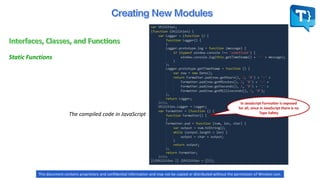
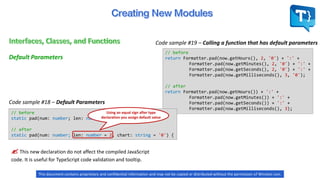

![Rest Parameters
Code sample #21 – Rest Parameters
function addManyNumbers(…numbers: number[]) {
var sum = 0;
for (var i = 0; i < numbers.length; i++) {
sum += numbers[i];
}
return sum;
}
var result = addManyNumbers(1,2,3,5,6,7,8,9); // 41
The compiled code in JavaScript
Code sample #22 – Mixed Normal and Rest Parameters
function addManyNumbers(name: string, …numbers: number[]) {
This document contains proprietary and confidential information and may not be copied or distributed without the permission of Winston Levi.](https://image.slidesharecdn.com/introductiontotypescriptbywinstonlevi-170216131827/85/Introduction-to-TypeScript-by-Winston-Levi-49-320.jpg)
